#Tesla Cybertruck stiffness
Explore tagged Tumblr posts
Text

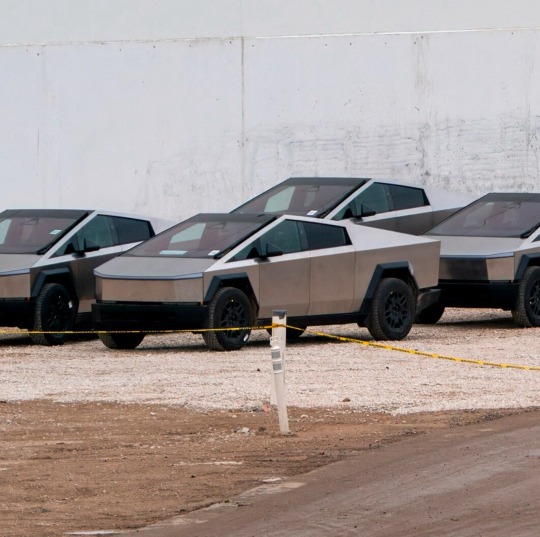
DURING THE CYBERTRUCK'S unveiling in 2019, Tesla CEO Elon Musk claimed that the electric vehicle's “ultra-hard stainless steel” body might be “literally bulletproof.” However, the Tesla truck's exterior panels appear to be defenseless against water pistols. They apparently rust, as some owners claim.
Posting on the Cybertruck Owners Club forum, a user named Raxar risked the wrath of the Tesla faithful—already exercised by the Cybertruck's numerous alleged design flaws—by stating that when they collected the $61,000 truck, “the advisor specifically mentioned the Cybertrucks develop orange rust marks in the rain.”
In a separate thread, the user vertigo3pc reported that “corrosion was forming on the metal” of his Cybertruck after it spent 11 days in the rain in Los Angeles.
Raxar, who also lives in California, posted what appeared to be close-up, rust-flecked images of his truck after driving it for two days in rain.
The Cybertruck does not ship with clear coat, that outermost layer of transparent paint that comes as standard on almost every new motor vehicle on the planet. Instead, each Cybertruck owner has the option to purchase a $5,000 urethane-based film to “wrap your Cybertruck in our premium satin clear paint films. Only available through Tesla.”
Who knew untreated stainless steel might not be such a good idea for the exterior of a motor vehicle, especially considering that cars typically get left sitting outside in all weather for 95 percent of their lives? The whole automotive industry, that's who.
Aside from the 1980s DMC DeLorean and a shiny 1960s Porsche, car companies have long steered clear of stainless steel panels. The material is heavy, relatively expensive, and hard to work with. It's also stiff, which makes it potentially more lethal to anybody unlucky enough to be struck by a vehicle built with the stuff.
(continue reading)
511 notes
·
View notes
Text
I can’t actually find anything, anywhere about significant injuries from an accident in a cybertruck. They’re garbage, obviously, but I just keep coming across articles about the first accident featuring a cybertruck where the driver sustained minor injuries and decided not to go to the hospital:
https://www.motor1.com/news/702666/first-tesla-cybertruck-crash-photos-and-video/
The bigger risk seems to be to other vehicles and pedestrians than the people inside:
https://www.reuters.com/business/autos-transportation/tesla-cybertrucks-stiff-structure-sharp-design-raise-safety-concerns-experts-2023-12-08/
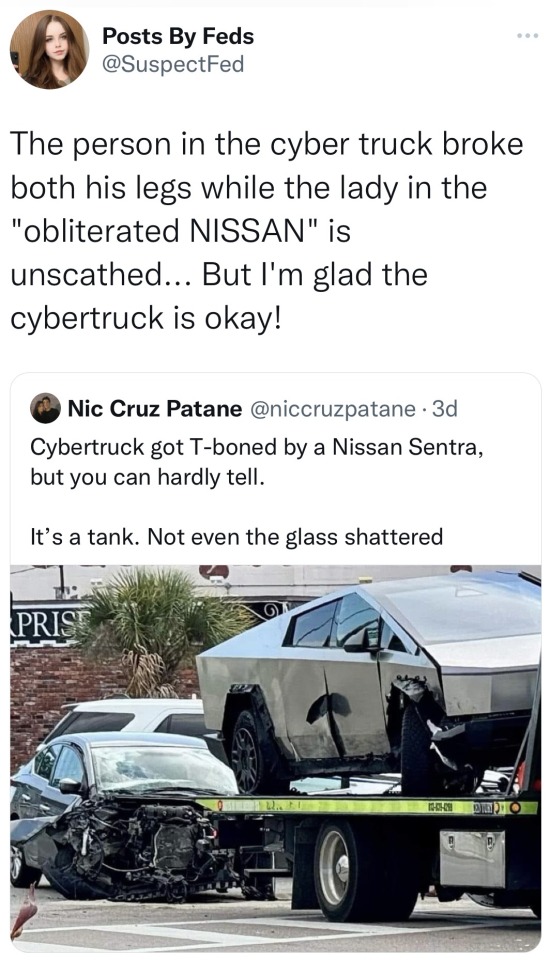


#fact check#fuck tesla#but fuck liars too#please prove me wrong if you can#always happy to dunk on elon
85K notes
·
View notes
Text
Tesla Cybertruck's stiff structure, sharp design raise safety concerns -experts
Tesla’s new Cybertruck is proven on display at a Tesla retail outlet in San Diego, California, U.S., November 20, 2023. REUTERS/Mike Blake/File Photograph Purchase Licensing Rights Dec 8 (Reuters) – The angular layout of Tesla’s (TSLA.O) Cybertruck has basic safety professionals concerned the electrical pickup truck’s rigid stainless-metal exoskeleton could damage pedestrians and cyclists and…

View On WordPress
0 notes
Text
Tesla Cybertruck's stiff structure, sharp design raise safety concerns
https://www.reuters.com/business/autos-transportation/tesla-cybertrucks-stiff-structure-sharp-design-raise-safety-concerns-experts-2023-12-08/
0 notes
Text
Unsafe Design? Experts Raise Concerns about Tesla Cybertruck - Technology Org
New Post has been published on https://thedigitalinsider.com/unsafe-design-experts-raise-concerns-about-tesla-cybertruck-technology-org/
Unsafe Design? Experts Raise Concerns about Tesla Cybertruck - Technology Org
The safety of Tesla’s Cybertruck is raising concerns among experts due to its angular design that features sharp edges and stiff stainless-steel exoskeleton structure which is most likely not compatible with the latest trends in automotive safety.
Tesla Cybertruck in a showroom – illustrative photo. Image credit: Phillip Pessar via Flickr, CC BY 2.0 DEED license
Six safety professors and officials, who analyzed crash test videos presented during a webcast delivery event, expressed worries about potential harm to pedestrians, cyclists, and other vehicles on the road, Reuters wrote in a recently published article.
Despite discussions on social media regarding the live-streamed crash test videos on November 30, experts emphasized the need for comprehensive crash-test data to draw definitive conclusions about the vehicle’s safety.
Previously, regulatory authorities were unimpressed by Elon Musk’s statements about the car’s ‘waterproof’ rating.
“The big problem there is if they really make the skin of the vehicle very stiff by using thick stainless steel, then when people hit their heads on it, it’s going to cause more damage to them,” explained Adrian Lund, the former president of the Insurance Institute for Highway Safety (IIHS), the organization responsible for an industry-standard for vehicle crash tests.
Previously, Tesla highlighted the Cybertruck’s structural elements designed to absorb impact during crashes. Tesla CEO Elon Musk said he was confident in the Cybertruck’s safety, claiming it would be safer for both occupants and pedestrians than other vehicles of the same class.
The vehicle’s unique design features flat planes and long, linear edges, making it visually distinct. It is the first car with a stainless-steel exterior since the introduction of the DeLorean car in 1985’s “Back to the Future.” Musk mentioned that the material’s toughness even caused the stamping machine to break while forming the panels.
Written by Alius Noreika
You can offer your link to a page which is relevant to the topic of this post.
#Angular#Article#Authored post#automotive#CEO#comprehensive#crash#Cybertruck#data#Design#Elon Musk#exoskeleton#Explained#Featured technology news#Features#Future#Image of the week#Industry#insurance#it#Link#material#media#Musk#organization#Other#photo#planes#president#safety
1 note
·
View note
Text
I was referencing the things put forth by OP, in order:
Huge wiring harnesses simplified: Cybertruck Guy and Radmad are both wrong, for different reasons.
Current industry standards don't have separate wires for each individual switch or control, either. They group several switches, lights, etc. that are nearby together, run them into a microcontroller, and put that controller on a vehicle bus. Currently that's usually a CAN (redundant, fault-tolerant) or LIN (neither, but much simpler) bus. This drastically simplifies wiring harnesses.
The main thing Tesla has done is change the DC voltage for that bus from 12 V to 48 V nominal. Since power is voltage times current, and wire thickness is dependent on current, this cuts about half the copper mass out of the power lines in the harness. The other (data) lines were already using smaller wires. The industry has been flirting with a 48V bus for around two decades by now; Tesla just went and did it and dealt with the engineering problems when they popped up. And this is a rare case where "they're a bunch of Silicon Valley nerds" may have helped: datacenters have been using 48V DC for in-rack power delivery for decades, so they had more familiarity with it than Detroit.
They've also adopted single-pair Ethernet (1000base-T1) for the high-speed entertainment data links. This technology has been in the industry since late 2016. It's usually integrated directly onto the custom ICs in ECUs. I remember another thread like this with a tweet where someone was complaining about the fragility of RJ-45 plugs and how that's disqualifying for a vehicle, and he's right, but single-pair Ethernet does not use those jacks; it's integrated into wiring harnesses with everything else.
Astronauts laded on the moon with altitude markers hand etched on the window: That was a backup system dramatized by the Apollo 13 movie. They had an inertial navigation system, like aircraft do, as their primary navigation.
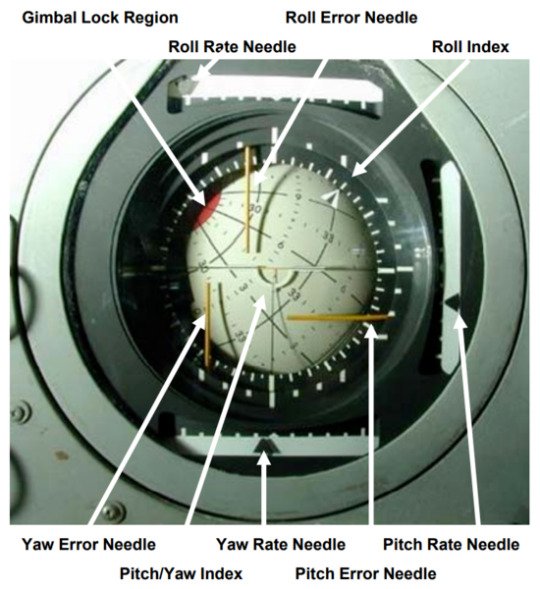
Oh, and it's attitude, not altitude. Very different concepts that folks should not mix up.
Can't get a rocket off the pad without blowing up: Neither could NASA their first few years. Meanwhile SpaceX had 98 successful orbital flights last year, and they can reuse their boosters (the record is 18 times). But that's way off topic.
Tesla Model Y broke: It's not news when non-Teslas lose power steering, apparently. And I've had cars that took many more than three appointments to fix. We can throw around anecdata all day.
Series wiring like Christmas lights: Come on, you've got no basis for that.
It's like the Titan sub: Sigh. Really?
Okay, now to the RDN link:
the vehicle’s angular design and stainless steel body could pose danger to other road users
Absolutely true. Also true of almost every luxury pickup truck on the market. One example:
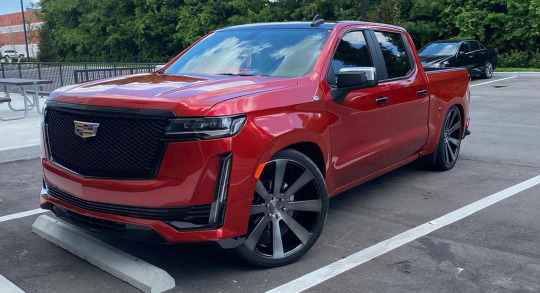
I'm all for figuring out some kind of regulatory regime to rein this in. Or maybe a modification of liability rules and increased insurance coverage minimums.
“The big problem there is if they really make the skin of the vehicle very stiff by using thick stainless steel, then when people hit their heads on it, it’s going to cause more damage to them,”
True, but it's not that thick or stiff; the speaker was speculating. Other have pointed out that "we shot it with a Tommy gun" is a lousy test because the bullets are rather low velocity. If you watch the side impact crash test, you can see the side panels visibly flexing.
And right after that, an IIHS rep said, “IIHS hasn’t evaluated the Cybertruck. The discussions we’ve seen so far appear to be based on speculation. I would add that our experience with Tesla is that they aim for the highest safety ratings in IIHS tests. We have no reason to expect anything different with the Cybertruck.”
The biggest problem with Teslas, from insurance companies' perspectives, has been that airbag-deployed collisions tend to result in totaling the vehicle more often than in other cars. Occupant safety, on the other hand, seems to be better than average. We've seen people walk away from their Model 3s after they got T-boned by speeding pickups (60-ish MPH in a 30 zone). We know this from accident reconstruction and camera data.
There's a linked video in the article comparing the Tesla Cybertruck collision to a Dodge Ram 1500. There are several others like it on YouTube (I saw one that had six trucks in it, all synced up). They all have the same flaw: they're comparing different crash types. The Cybertruck is doing a full frontal crash, where you drive the vehicle into a solid, immovable wall, while the others are moderate overlap crashes, where the hood goes over the obstacle and only the left 1/3 of the vehicle is obstructed, so the engine can deflect to the sides instead of going into the firewall and then the passenger compartment. The Cybertruck, of course, does not have a large engine in that space; it's mostly cargo storage. And we can clearly see it crumpling and the front wheel moving outward instead of back into the passenger compartment, like practically all cars do now.
(Some folks like to point out how the rear wheel breaks away, too: this is expected because it's a steering wheel, since the Cybertruck has four-wheel steering, and uses the same suspension technology as the front, instead of connecting the rear wheels more directly to the rear axle like most vehicles. Not completely directly, though, like the Chevy Corvair's swing axles. In any case, kinetic energy breaking the rear wheels off like that is energy that isn't compromising the cabin.)
The article addresses the "lack" of crumple zones:
Samer Hamdar, a George Washington University auto safety professor, told Reuters that while a lack of crumple zones concerned him, there could be other factors that accounted for it. “There might be a possibility of shock-absorbent mechanism that will limit the fact that you have a limited crumple zone,” Hamdar said.
I'm not going to speculate about crumple zones beyond the above ("the cargo area collapses, taking some energy with it; we have to see if that's enough to call a crumple zone, but it's not nothing") until someone tears one down and documents it. But crumple zones aren't the only means of keeping kinetic energy out of the passengers.
The rest of the article goes back to concerns about pedestrian safety, which seem to be the main substantive concern, and is noted at the end of this video:
youtube
And again, pedestrian safety is an industry-wide problem. We need another Ralph Nader, but demonizing Tesla alone (god it's so easy, Elon is such an asshole) only gives cover to the rest of the industry. And none of the tweets in OP's post spoke of this.

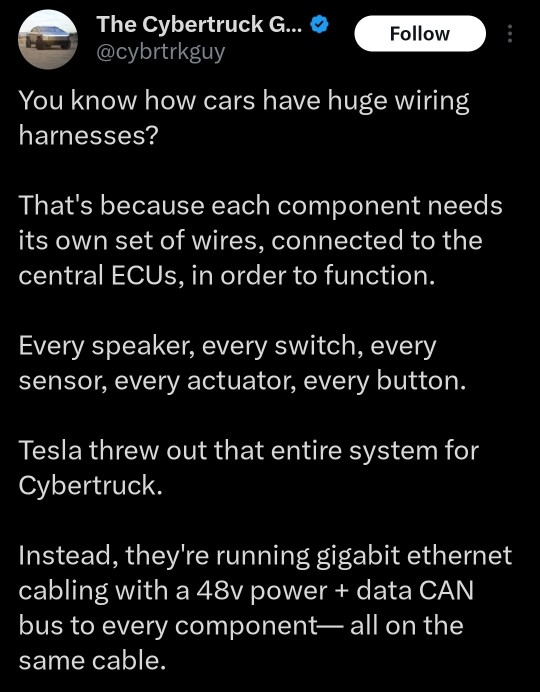

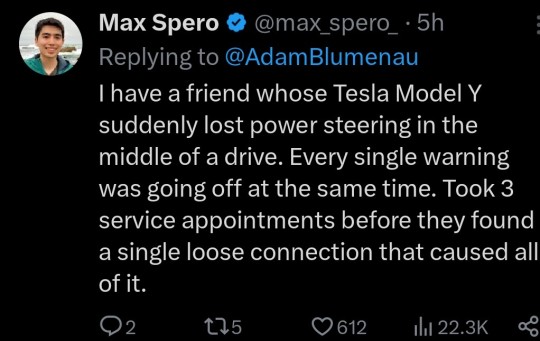
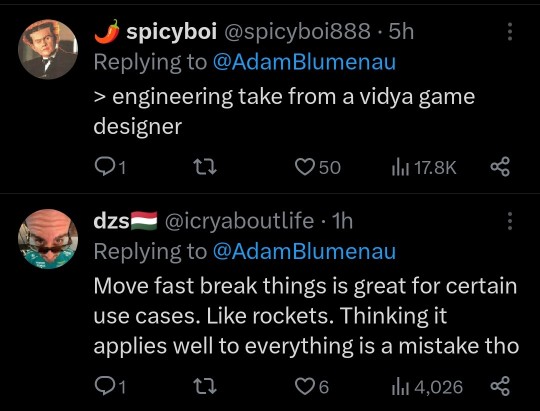


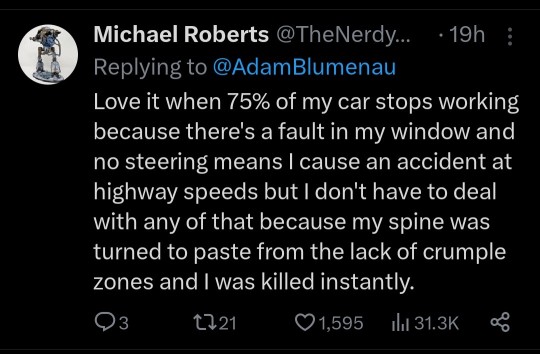
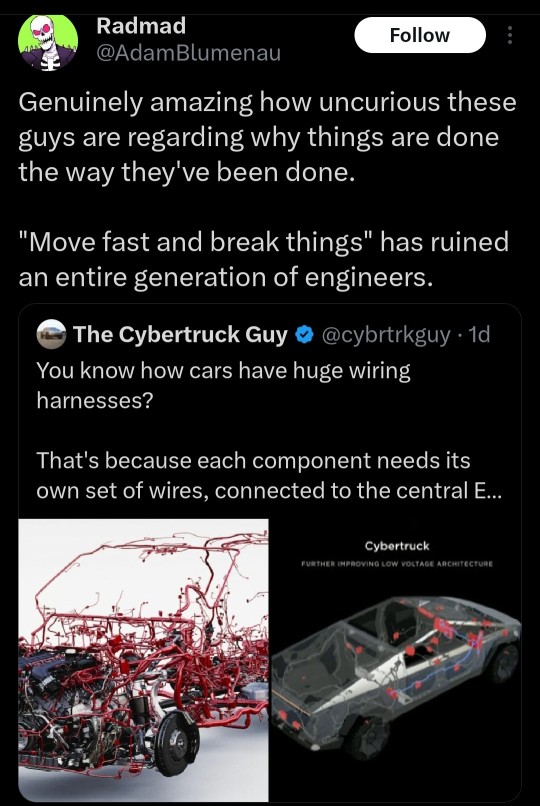
42K notes
·
View notes
Photo

We knew it was going to happen! LEGO® brick build TESLA CYBERTRUCK WIDE BODY DRIFT CAR🏁🏁🏁 Its sitting low on the ground, got a full wide body kit and a rear duckbill wing, a full cage for additional stiffness as the whole body was replaced with a lighter carbon fiber one (let's use our imagination) and some additional cooling fans on the bed for those batteries! Hope you like it! The CYBERSLEIGH is coming soon as well, there's a sneak peek of it at our Facebook page 🎅😉 __ Message me for custom Lego sets(car list available in stories) 📩 __ #sp_lineup #lego #afol #moc #tesla #cybertruck #teslatruck #teslamotors #tesla #cyberquad #legogram #instalego #legocar #legotruck #legos #legobricks #legophotography #custommade #brickmade #oneofakind #electric #widebodykit #widebody #teslawidebody #drifting https://www.instagram.com/p/B56p8hZHmb3/?igshid=1x3b7f9lvxo
#sp_lineup#lego#afol#moc#tesla#cybertruck#teslatruck#teslamotors#cyberquad#legogram#instalego#legocar#legotruck#legos#legobricks#legophotography#custommade#brickmade#oneofakind#electric#widebodykit#widebody#teslawidebody#drifting
1 note
·
View note
Text
Rivian’s Electric Pickup Truck Is Already Sold Out
[ad_1]
The R1T will have stiff competition when it arrives as it will go up against the Tesla CyberTruck.

By Sahil Gupta | Published: 23-Nov-20 04:25 PM IST 0 Views
View On WordPress
0 notes
Note
Tesla's offerings are not aging well and Cybertruck is a disaster. Their design language is stuck in 2012 with no refresh planned. Build quality still sucks and the Nazi thing makes buying a new Tesla very polarizing. Even if you're a stiff-armed Musk worshipper it's probably nerve wracking to leave your car unattended.
Fleet buyers (Hertz, Enterprise) are dumping their Teslas. The used Tesla market is flooded meaning that prices go down down down which further impacts new Tesla purchases. After all, why pay $50K+ for a new Model 3 when a used low mileage 2023 sells for $24K?
And let's not even talk about Europe, where things are 10x worse for Tesla.
All of this to say that Tesla's value is wholly subject to whatever Trump can do to prop it up. Via subsidies, mass government contract buys, or propaganda. Like the White House shitshow Tesla ad delivered last week.
And Trump is only going to keep that up while Musk is useful. Right now Musk is an excellent lighting rod for hate, his DOGE entity acting as a rage heat-sink for everyone who should, by rights, be pissed at Trump.
But that time is limited.
Musk will eventually get ejected from Trump's inner circle, the same way he treats everyone who's been there.
I'm betting it's before 2026. Right about when midterms start heating up.
do you think elon actually cares at all about what’s happening to teslas stock right now? or do you think these are acceptable/accounted for short term losses while he leverages his government position to achieve deregulation and legal protection for self driving cars, which will send teslas stock into the stratosphere?
Oh I am sure he cares - that is just too much money to lose to not care, and he is A: someone who cares about his net worth as a metric for his personal success/legacy, B: is using that wealth extensively to serve his political ambitions, and C: said political ambitions depend extremely heavily on one guy's opinion of him and that guy respects money more than anything else on this earth.
I bet he isn't too cuffed about it though because the headline numbers are masking how "normal" this is:
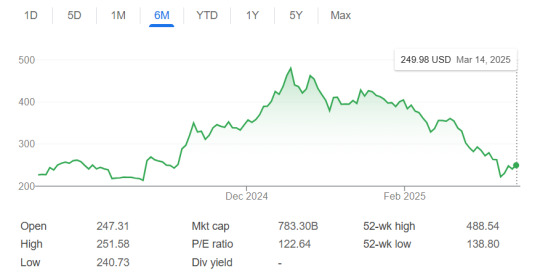
Like obviously Tesla stock has always defied gravity and been heavily overvalued, I bet Musk let himself maybe kind of half-believed that this would last too. But with absolutely no notable increase in profit or fundamentals, the stock price for Tesla simply doubled post election. This was obviously bullshit, it was absolutely going to go back down in some form, and it is back to where it was in the middle of 2024 when Musk was still the richest person on the planet. Calling this him "losing" money is, in a certain sense, inaccurate (accurate in other senses ofc) - this is just churn of a ticker number, Musk was not selling tons of equity or anything around this.
As for that last part, I don't think that ideas has any real legs to it. Tesla is not even the leader in the AI car space, it is going to be a slow roll technology (cars are a consumer good, consumers are sticky on habits), and software like that is typically quite hard to monopolize. Tesla can certainly make some money on self-driving cars! But I see no reason to think it will be some magic ticket for them. Honestly I am bearish on the company right now - Tesla has not posted amazing results and the competition in EV space is fierce and surpassing them.
And I don't think his government position will bail him out too much. It will help, don't get me wrong, (Trump is super corrupt!) but it isn't why he is doing it and he won't prioritize it. Musk is a true believer in what he is doing. Which, to be clear, is way, way worse than if he was just doing it for the cash.
46 notes
·
View notes
Text
Rivian’s Electric Pickup Truck Is Already Sold Out
The R1T will have stiff competition when it arrives as it will go up against the Tesla CyberTruck.

By Sahil Gupta | Published: 23-Nov-20 04:25 PM IST 0 Views
View On WordPress
0 notes
Text
Tesla Cybertruck's stiff structure, sharp design raise safety concerns -experts
Tesla’s new Cybertruck is proven on display at a Tesla retail outlet in San Diego, California, U.S., November 20, 2023. REUTERS/Mike Blake/File Photograph Purchase Licensing Rights Dec 8 (Reuters) – The angular layout of Tesla’s (TSLA.O) Cybertruck has basic safety professionals concerned the electrical pickup truck’s rigid stainless-metal exoskeleton could damage pedestrians and cyclists and…

View On WordPress
0 notes
Text
What Is the Difference Between an SUV and a Crossover?
Alex Trebek looks at you and then carefully reads the card:
“While one of them rests on a ladder frame, the other has unibody construction” and then he looks up.
If you were a Jeopardy contestant and shouted “What is the difference between an SUV and a Crossover?” Alex would announce, “Correct!” You’d win the $300, and then shoot a knowing wink at the home audience. Saying that SUVs ride on ladder frames and crossovers have unibodies is the simplest, correct-est answer.
Yet there’s another, squishier answer, sort of the vehicular version of Supreme Court Justice Potter Stewart’s “I know it when I see it” for how he identified obscenity in 1964. And I’ll get to that at the end.
First off, what’s a ladder frame?
The ladder-frame chassis of the 2020 Chevrolet Suburban.
It’s pretty close to what it sounds like—two parallel rails with interconnecting stiffeners, laid horizontally. Stood up on end, it resembles a ladder. Spanning nearly the length of a vehicle, it’s a car’s steel skeleton, holding together all its major organs—engine, transmission, suspension, wheels, and bodywork skin—in place. Ladder frames are rampant among trucks, underpinning almost all of them (except for a few oddballs like the Honda Ridgeline and Tesla’s Cybertruck). And, judging by our Jeopardy success, underpinning SUVs as well.
The automotive ladder frame is ancient genetic material. Horse-drawn carriages were built upon them, and early car-builders (notably, Studebaker) just carried on with the practice as they transitioned from animal horse-power wagons to combustion horsepower cars. This wasn’t just a stubborn, archaic tradition, though. The rutted roads of the early-Twentieth Century required huge, heavy wheels, and together with a primitive understanding of springing and damping, it was a good thing that the ladder frame flexed a bit too. It was literally part of the suspension, the whole car becoming a giant spring, with weights and mini-dampers often attached to either end to tamp-down any nasty resonances. The emphasis was on strength, not stiffness, plus, a live axle-on-leaf-spring suspension easily mated with frame-rails.
As roads became paved and smoother, wheels and suspensions could be smaller and lighter, so having a flexible frame mattered less – and finally, an outright hindrance as brands (notably, Cadillac) better understood suspension theory. For instance, ride quality is helped by minimizing “unsprung weight” (considered the wheels, tires, and axles, plus half the pivoting parts). A heavy ladder frame is the last thing you want as part of the suspension mix.
OK, so what’s a unibody?
A Volvo XC40 showing off its unibody structure.
Like a ladder frame, a unibody is also what it sounds like. Instead of underfloor frame rails doing the work while the bodywork’s simply worn like a big hat on top, here, the whole, thin-gauge sheet metal structure—usually excluding most of the bodywork skin itself—carries loads. It’s distributed. As an aside, the French word monocoque, meaning “single shell,” is the unibody’s kissing cousin, except that much of its bodywork is substantially stressed as well, like a jetliner’s. It’s a rarity, usually seen in racing. (Though in that realm, its meaning is obviously malleable; many one-piece carbon-fiber racing chassis—with non-stressed bodywork, so just like a unibody—are commonly called monocoques, a term that’s simply more popular in Europe.)
What’s good about unibody construction?
There’s a list of things. The structure’s comparatively huge cross-section (10 or more times a frame rail’s height) makes it tremendously stiffer for its weight. Or inversely, lighter for the same stiffness, which greatly improves mileage. Crash safety benefits, too, as its folded-origami construction can be designed to collapse progressively, reducing your body’s deceleration upon impact. And handling improves because the suspension can be more complex as it can attach to a more three-dimensional structure, while its connection points don’t flex around as much as the chassis distorts, letting the tires accurately do their work.
With all these advantages, why would anybody still build a ladder-frame SUV? Good question. Which is why the vast majority of the offerings out there are unibody crossovers. But there are few justifiable instances. Serious off-roading returns us to those rough roads of yesteryear, once again demanding heavy wheels and suspensions, and a strong (if not stiff) structure to attach it to. Towing loads can make a beeline through the frame rails to suspensions where the wheels are doing the pulling.
By the way—there are many other types of chassis concoctions besides ladder frames and unibodies. The 1934 Chrysler Airflow anticipated unibody construction with a hybrid blend of a tubular skeletal frame webbed by load-bearing panels. Today’s C8 Corvette is hard to categorize, being a structure composed of cast, extruded, and sheet aluminum, all bonded together (the body is a non-load-bearing envelope).
What is it—an SUV or a crossover?
And what about Supreme Court Justice Stewart’s definition? I once attended a lunch with Subaru product planners who wanted our opinion on a new product they were considering “What if we raise the Legacy wagon (it had FWD) and give it all-wheel drive?” I thought they were crazy and said so. The SUV craze had just started and Subaru wanted in on it without actually building an SUV. So was born the Outback—what we now call a crossover. And why I’m not a product planner.
If a manufacturer thinks it’ll sell more unibody crossovers by giving them tough, SUV looks that we “know when we see it,” nobody can stop them. But it isn’t going to impress Alex Trebek.
The post What Is the Difference Between an SUV and a Crossover? appeared first on MotorTrend.
https://www.motortrend.com/news/what-is-the-difference-between-an-suv-and-a-crossover/ visto antes em https://www.motortrend.com
0 notes
Video
instagram
A little stiff and noisy but it looks great and works as designed. The black swingarm runs against the body of the #CYBERTRUCKZILLA so it will need to be tweaked a little in the final design and if it is an issue we can simply cut it off. Amazing and complex design by @antsinafrica Andy is enjoying assembling this so much!! @tangiblecreative_official is reprinting the rear swingarm since the Chiron seems to be out of commission. #makersgonnamake ◇◇ ◇◇ ◇◇ #CYBERTRUCK #teslamotors #tesla #teslagram #TeslaCYBERTRUCK #cybertrucktesla #teslatruck #elon #elonmusk #musk #STEM #steam #plaidCYBERTRUCK #3dprint #3d #3dprinted #3drevolution #3dtoys #3dprintinglife #3dtoy #antsinafrica #additivemanufacturing #Tangiblecreative @andystechgarage #atg #andystechgarage ⚠️DO NOT REPOST❗⚠️ https://www.instagram.com/p/CBVSPCBDmOz/?igshid=1bpdmfvz1eeiu
#cybertruckzilla#makersgonnamake#cybertruck#teslamotors#tesla#teslagram#teslacybertruck#cybertrucktesla#teslatruck#elon#elonmusk#musk#stem#steam#plaidcybertruck#3dprint#3d#3dprinted#3drevolution#3dtoys#3dprintinglife#3dtoy#antsinafrica#additivemanufacturing#tangiblecreative#atg#andystechgarage
0 notes
Text
Tesla’s cars and trucks aren’t ideal– here are all their most disappointing features
The Tesla Model 3. not quite best.
Matthew DeBord/BI.
Tesla’s lorries are usually outstanding.
However they aren’t ideal. The Design 3, Model S, Model X, the initial Roadster, Model Y, and Cybertruck all have frustrating defects.
Here’s a rundown of whatever I do not much like about the automobiles, from charging times to confined seats to weak design.
Visit Company Expert’s homepage for more stories
No car is.
In Tesla’s case, I went back over all the cars I’ve driven or assessed in some way and rounded up their flaws.
Here’s the rundown:
I’m a huge fan of Tesla’s vehicles. I’ve driven nearly all of them, and I in fact think the Design 3 might be the most idea-packed auto ever produced.
Tesla Design 3.
Matthew DeBord/BI.
The ultra-minimalist Model 3 interior sets a tone. If you like an uncluttered life, it’s for you. If you delight in some buttons and knobs due to the fact that they’re simpler to utilize than touchscreen technology, then you’re going to have a stuffed relationship with the Design 3.
Tesla Model 3.
Tesla.
The Design 3 has a wonderful glass roof, however to make it work, the fastback hatch is compromised. Thus, the Design 3 has a truck cover with a large cutout.
Tesla Design 3.
Hollis Johnson/Business Expert.
Which remains in exchange for a beautiful stock 15 cubic feet of freight capability.
Tesla Design 3.
Matthew DeBord/BI.
The front trunk, or frunk, makes up for it. But that does suggest you have two hatches to handle.
Tesla Design 3.
Matthew DeBord/BI.
The Majority Of the Model 3’s automobile functions are combined in a central, landscape touchscreen that beings in the middle of the lorry’s dashboard.
Tesla Model 3.
Matthew DeBord/BI.
In a week of testing, I grew tired of constantly having to communicate with screen. It didn’t damage my total impression of the Design 3, but to this day I long for more buttons whenever I evaluate a vehicle that’s following the Design 3’s lead.
Tesla Design 3.
Matthew DeBord/BI.
The Model 3 has an aftermarket wireless charging option that owners can acquire, but the stock 3 does not have the function, which has become fairly standard on high-end cars.
Tesla Model 3.
Matthew DeBord/BI.
The Model 3’s guiding wheel removed many multifunction buttons that are now typical. Instead, you get 2 thumb-wheels, which have to carry out a number of tasks apiece. Some folks enjoy the iPhone-ish simpleness of this plan. I’m not one of them.
Tesla Design 3.
Matthew DeBord/BI.
The Model S, in some methods, is Tesla’s masterpiece: it’s the very first clean-sheet style, introduced in2012 Not much to grumble about, however …
Tesla Model S.
Tesla.
… the Design S gave us both Ridiculous velocity mode and later Ludicrous Mode. These features are remarkable. Ludicrous Mode yields a 0-60 mph time that’s faster than some supercars. This is a SEDAN! Unless you want to tie whatever down, your Ridiculous runs may end up being more scarce.
Tesla Model S.
Mark Ralston/AFP.
The Model S is a slow, slow charger when you’re utilizing a fundamental wall outlet. It’s true “trickle” charging, about one mile per minute. In practice, unless you have a great deal of time to kill, it’s hardly worth it.
A Tesla Design S juices up behind a shed.
Matthew DeBord/Business Expert.
The Design X is Tesla’s most remarkable, modern lorry. It’s specified by its upswinging, falcon-wing rear doors.
Tesla Design X.
Tesla.
They are cool. After a few days of testing the Model X, I found myself wanting there was a more simple, old-school door alternative.
Tesla Model X.
Matthew DeBord/BI.
The Design X has a third-row choice. But since the SUV isn’t a proper full-size ute, there’s almost no space back there for normal-sized adult people.
Tesla Model X.
Matthew DeBord/BI.
Charging for Teslas is both a virtue and a curse. The business’s global Supercharger network is prevalent and enables fast-charged journey that surpass its cars’ currently significant range.
Tesla Design X.
Matthew DeBord/BI.
However the fastest charge can still consume an hour, depending upon how depleted the battery is. And while Teslas can compute how long to charge, based on how a trip has actually been outlined, it’s constantly longer than a five-minute fill-up in a gas-powered cars and truck.
Matthew DeBord/BI.
Like the Design 3, much of the Model X’s functions are handled through a substantial touchscreen, with a portrait design much like the Model S. And like the Model 3, one establishes a love-hate relationship with the setup.
Tesla Model X.
Matthew DeBord/BI.
The initial Roadster was Tesla’s first automobile, and it was groundbreaking: sexy and quickly, miles beyond the glorified golf carts that electrical cars had actually been.
The original Tesla Roadster.
Matthew DeBord/Business Insider.
However it likewise had maybe the worst infotainment system in all of cardom, even by the standards of the early 2000 s.
The initial Tesla Roadster.
Matthew DeBord/Business Insider.
The Roadster was also a relatively pure cars: heavy steering, a stiff flight, and absolutely no versatility.
The original Tesla Roadster.
Matthew DeBord/Business Insider.
The Model Y is Tesla’s newest lorry– and the crossover SUV is the company’s first unsightly effort.
Tesla Design Y.
Tesla.
Compact crossovers tend to be unimpressive aesthetically, anyway. However compared with Tesla’s current lineup, the Design Y is the ugly duckling.
Tesla Design Y.
Matt Debord/Business Expert.
I’m of two minds about Tesla’s semi-self-driving system, Autopilot. On the one hand, it has incredible capacity, although I don’t believe it’s now a lot more than innovative cruise control.
Benjamin Zhang/Business Expert.
The problem is that it’s rather tiring to use.
Benjamin Zhang/Business Insider.
The system is also lagging some of the much better highway-only hands-free offerings, particularly Cadillac’s Super Cruise tech.
Tesla.
The extreme brand-new Cybertruck has a questionable style, but I invited it. With the Design Y, the company has fallen into a rut.
Tesla Cybertruck.
FREDERIC J. BROWN/AFP through Getty Images.
Still, the Cybertruck echoes the Model X in having actually made complex, retractable bedspread for its “vault.”
Tesla Cybertruck.
Tesla.
Bed covers– or “tonneau” covers– are a familiar pickup-truck option.
Jeep Gladiator.
Matthew DeBord/Insider.
The Cybertruck likewise has a stainless-steel construction. That may sound outstanding. But there’s a factor we don’t have any stainless-steel cars and trucks– and haven’t since the unfortunate DMC DeLorean. Hmmm … also gull-wing doors.
A DMC DeLorean.
Timothy Morris/Getty Images.
Finally, while Tesla’s battery style allowed it to conquer the EV world early, it’s something of a long-lasting drawback. It consists of thousands of lithium-ion cells, all wired together in packs. The layout is inefficient– and highly lithium-dependent.
The inner guts of a Tesla Design S.
Cadie Thompson/Business Expert.
.
.
More:
Features BITranspo Tesla Tesla Take
Chevron icon It shows an expandable area or menu, or often previous/ next navigation alternatives.
.
.
%%.
from Job Search Tips https://jobsearchtips.net/teslas-cars-and-trucks-arent-ideal-here-are-all-their-most-disappointing-features/
0 notes
Text
Tesla reveals Cybertruck, but breaks its ‘unbreakable’ windows during unveiling
https://newsource-embed-prd.ns.cnn.com/videos/newsource-video-embed.js
HAWTHORNE, Calif. — The Cybertruck has arrived and it looks nothing like any pickup truck you’ve ever seen.
Tesla CEO Elon Musk revealed the long-awaited electric pickup truck at its Design Studio in California, just outside Los Angeles.
When the truck initially drove onto the stage, many in the crowd clearly couldn’t believe that this was actually the vehicle they’d come to see. The Cybertruck looks like a large metal trapezoid on wheels, more like an art piece than a truck.
Instead of a distinctly separate cab and bed, the body appears to be a single form. The exterior is made from a newly developed stainless steel alloy, the same metal that’s used for SpaceX rockets, Musk said. That alloy enables the car to be “literally bulletproof” against at least smaller firearms, including 9-millimeter handguns, Musk said.
A man with a sledgehammer hit the sides of the truck without damaging it. But a demonstration of the truck’s supposedly unbreakable metal glass windows backfired when a metal ball thrown at the windows did, in fact, break them.
“But it didn’t go through,” Musk sheepishly pointed out.
Incredible power at an incredible price
Musk has made striking claims about the truck’s capabilities. Among them, he has said the Cybertruck would be more capable, in terms of towing and hauling, than a Ford F-150, and it would perform as a better sports car than a Porsche 911.
The most expensive version of the truck, the Tri Motor All-Wheel-Drive, will be able to carry 3,500 pounds, tow up to 14,000 pounds and go from zero to 60 in 2.9 seconds. It will also be able to drive up to 500 miles on a full charge. Base models will have a range of 250 miles.
In addition to being able to carry cargo in its bed, the truck will have lockable storage spaces under the hood and in the sides. The bed itself also has a sliding cover. Drivers will also be able to adjust the ride height of the truck, for when they are on the highway or off-road, using an adaptive air suspension system.
Another eye-catching feature of the truck is its price. The base version of the truck will start at $39,900. That’s only about $10,000 more than the price of a base model Ford F-150, which starts at about $30,000. But it would compete well with the cost of a nicely equipped F-150. An F-150 Lariat Super Cab, for instance, starts at about $44,000.
Prices for the top end Tri Motor AWD version of the Cybertruck start at $69,900. Buyers will also be able to choose Tesla’s “self-driving” option for $7,000. (The truck should be able to drive itself once the software for that becomes available.)
Musk had one final surprise as the presentation was wrapping up.
“Oh, yeah,” he said. “We also made an ATV.”
With that, a rider came out from a side room on a small electric all-terrain vehicle. He flipped down the truck’s tailgate, extended a built in ramp, and rode it up into the bed.
‘A niche product at best’
Tesla’s new electric truck won’t be without some stiff competition. It’s going up against the two market leaders in full-size trucks in America. Ford is developing its own electric F-series truck, while General Motors, which makes Chevrolet and GMC pickups, also has its own electric pickups in the works. Earlier Thursday, GM CEO Mary Barra said the auto maker expects to begin selling its electric pickup in the fall of 2021.
Rivian, a Michigan-based start up also plans to begin selling its own electric pickup next year. The company counts Amazon and Ford as major investors. Rivian founder, R.J. Scaringe, ranked third on this year’s just-released Motor Trend Power List, a largely subjective ranking of relative auto industry mojo. Musk ranked 24th. Rivian’s trucks will cost tens of thousands of dollars more then Tesla’s, but they will look far more like trucks.
The market potential for Tesla’s truck remains somewhat of a mystery. There has, to date, been little overlap between full-size pickup truck buyers and Tesla buyers. For instance, Teslas and other electric cars sell well on America’s coasts, while large pickups sell best in the Midwest.
Also, Tesla’s Cybertruck looks nothing like a traditional pickup. Truck buyers may want to stand out, but it’s unclear they’ll be comfortable with standing out quite so much.
“It will be a niche product at best and poses no threat in the pickup market as we know it today. The other downside is that this truck will have no federal tax credits by the time it comes out,” said Matt DeLorenzo, senior executive editor at Kelley Blue Book.
Musk has said in the past that the pickup is something of a personal pet project and he doesn’t care much if few people actually want to buy it.
Chelsea Sexton, an analyst who covers the electric vehicle market, said she doesn’t believe the truck Musk showed is very close to the final production vehicle.
“From a specification standpoint, I believe that’s probably what they’re aiming for but, no question, that body style that is not a high volume product,” she said.
Production will begin in late 2021, with production of the Tri Motor AWD version of the Cybertruck beginning a year later, according to Tesla.
from FOX 4 Kansas City WDAF-TV | News, Weather, Sports https://fox4kc.com/2019/11/22/tesla-reveals-cybertruck-but-breaks-its-unbreakable-windows-during-unveiling/
from Kansas City Happenings https://kansascityhappenings.wordpress.com/2019/11/22/tesla-reveals-cybertruck-but-breaks-its-unbreakable-windows-during-unveiling/
0 notes